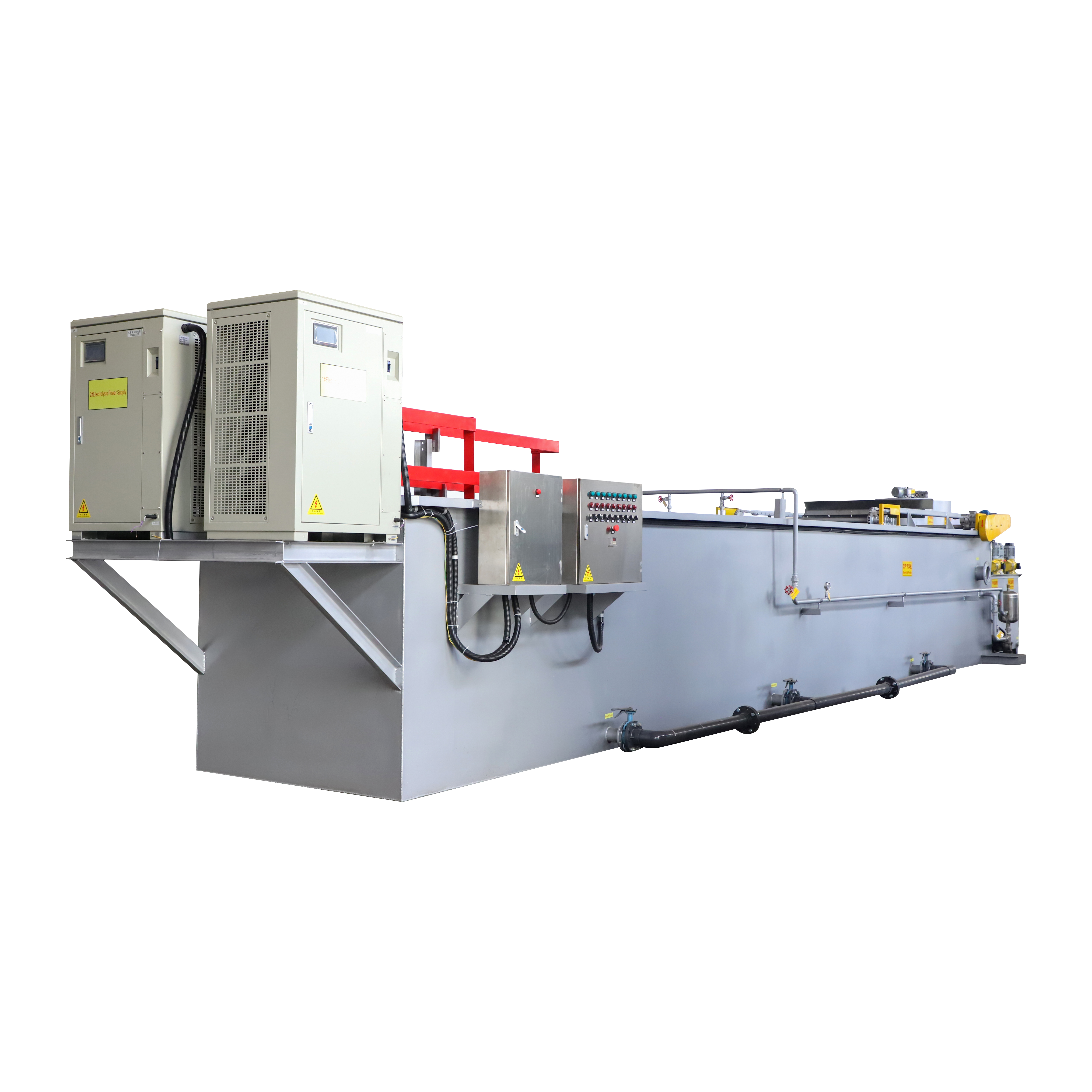Electrolysis Process in Industrial Waste Water COD Removal
Under high salinity conditions, wastewater has high electrical conductivity, a feature that provides a good scope for the development of electrochemical methods in the treatment of high salinity organic wastewater.
High-salinity wastewater undergoes a series of redox reactions in the electrolytic tank to produce insoluble substances, which are removed by precipitation or air floatation, or direct redox to harmless gases, thus reducing COD.
When sodium chloride in solution is electrolyzed, some of the chlorine gas generated at the anode is dissolved in the solution to produce hypochlorite and chlorate by secondary reaction, which plays a bleaching role in the solution. It is the combined synergistic effect of the above that degrades the organic pollutants in solution
QDEVU EC+DAF SYSTEM is a integrated technology combined the Electro-coagulation(EC) and Dissolved Air Flotation(DAF) system,which can complete the process of Oxidation, Reduction, Flocculation and Air Floatation at one time.
The organic or inorganic substances in the wastewater can be oxidized and reduced by the EC+DAF SYSTEM, and then coagulated and floated to separate the pollutants from the water body, which can effectively remove Cr6+, Zn2+, Ni2+, Cu2+, Cd2+, CN, oil, phosphate, CODcr, SS and color in the comprehensive electroplating wastewater.

WORKING PRINCIPLE
QDEVU EC+DAF SYSTEM uses the principle of electrochemistry to produce electrochemical reactions under the action of electric current, converting electrical energy into chemical energy, making pollutants into ions with electric charge and releasing electrons.
QDEVU EC+DAF SYSTEM uses soluble metal aluminum as the pole plate, under the action of direct current, releasing Al ions, and the aqueous solution dissociates into H+ and OH-, and the resulting ions combine with the (OH-) produced by the ionization of water to produce flocculation compounds. The generated ions combine with the (OH-) produced by the ionization of water to produce a flocculating compound without the addition of PAC flocculating agent.
FUNCTIONS
Electrolytic Oxidation
The oxidation in electrolysis is divided into direct and indirect oxidation.
- Direct oxidation, that is, the pollutants in the water body directly in the anode loss of electrons and oxidation.
- Indirect oxidation, the use of certain anodic reaction products (such as Cl, ClO, O2, H202) and other indirect destruction of pollutants.
Electrolytic Reduction
Hydrogen is electrolyzed from the cathode under the action of an advanced power source, and free hydrogen is formed in the water under the action of a high voltage electric field.
The free hydrogen is the strongest reducing agent, which can degrade organic matter by direct reduction of cathode, and indirect reduction can reduce metal ions into metal monomers to further remove pollutants and improve treatment efficiency.
Electrolytic Flocculation
Soluble anode, such as Al anode, under the action of power supply, the anode loses electrons and forms metal cation Al, which is oxidized and hydrolyzed into hydroxide colloidal flocculant with strong adsorption capacity to remove pollutants in wastewater by adsorption and co-sinking.
Electrolytic Air Flotation
Electrolytic air floatation is the electrolysis of water, when the voltage reaches the decomposition voltage of water, hydrogen and oxygen are precipitated at the cathode and anode voltage respectively.The fine bubbles of hydrogen and oxygen make flocculants or oil attached to the bubbles float to the liquid surface to facilitate the removal of this method is called electrical flotation.
Electroflotation removes both hydrophobic and hydrophilic contaminants from wastewater. The hydroxide produced by the electroflocculation process is more active than that of the pharmaceutical method, and the coagulation and adsorption capacity is stronger, so the treatment effect is good.
In the process of electric flocculation, the oxygen and hydrogen produced on the anode can oxidize the organic matter into harmless components and play a sterilizing role, while the reduction on the cathode is the oxidizing pigment reduction into colorless substances.
APPLICATIONS
- Electroplating wastewater treatment
- Pharmaceutical wastewater treatment
- Chemical wastewater treatment
- High concentration wastewater treatment
Visit www.evuchina.com for more informations!
#QDEVU #ELECTROCOAGULATION #DAF #FLOTATION #WATERTREATMENT #WASTEWATERTREATMENT #SEWAGETREATMENT #SEWAGEWATERTREATMENT #WATERFILTER #WATERFILTRATION #SLUDGETREATMENT #SLUDGEDEWATERING



